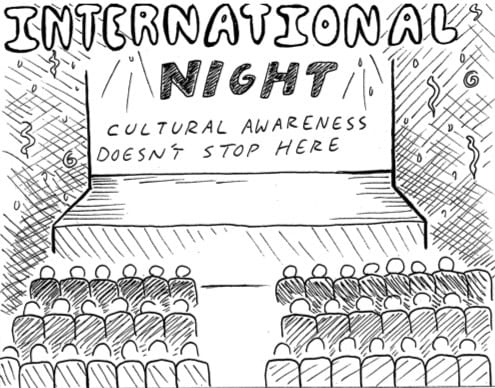
Every beginning of September, St. Olaf sees an influx of international students during week zero, a week designed to prepare these students for the next four years in the United States. Jetlagged and overwhelmed, these students start to form relationships amongst themselves while waiting for the rest of the first-year class to join them. Once the school year starts, the co-curricular fair – presented by Student Government Association (SGA) – becomes the next step that shapes all first-year social lives at St. Olaf.
Students get a chance to explore different clubs offered by the College to find what interests them. Among the clubs hoping to gain new members, are the cultural clubs at St. Olaf, including Team Tibet, Presente, Korean Culture Association (KCA), Karibu Association and many others. One goal of cultural clubs is to create awareness and celebrate other cultures on campus. Most importantly, however, is the goal to challenge domestic students to engage with different world cultures.
During the co-curricular fair, first-years are trying to find a community – whether that be through sports, knitting, singing or a cultural club – and they usually tend to sign up for clubs they feel that they fit in. For domestic students, cultural clubs are not always a place they feel they fit, so they tend to join clubs other than cultural clubs. International students, however, are drawn towards the clubs that celebrate their own cultures, especially because everything around them – including classes, food and language – is all so American. They hope to find a community in which they can interact with people who are going or have gone through a similar transition.
As an international student, being part of a cultural club gives me a richer experience at St. Olaf. I get to be part of United States culture (obviously!) through my everyday life at Olaf. But, I also get to interact with people from all over Africa and the Caribbean through Karibu, which is a club that celebrates African and Caribbean cultures. Through the rich conversations held in cultural clubs, I am challenged to listen to and learn from stories of Oles whose backgrounds define diversity.
This exchange of cultural knowledge is something domestic students can benefit from to expand their understanding of life in other continents. Of course, some domestic students do join cultural clubs. For instance, Team Tibet has many domestic students showing up to meetings and participating in events every year, but overall few students take advantage of the diversity at St. Olaf.
In my opinion, St. Olaf has taken the first step in connecting its student body with unfamiliar cultures, which is allowing cultural clubs to exist. The clubs open their doors for everyone to join and learn from them. The only remaining effort is that of domestic students to show up to some of these clubs and learn about the world outside of the United States.
Attending African Night, Carribean Night, International Night or the Lunar New Year performances is not enough to inform anyone about international cultures that reside at St. Olaf. I believe that these events are a chance for international students to come together and celebrate their cultures and differences, instead of the common misconception of existing to entertain domestic students. Don’t wait for International Night to experience the differences that roam around St. Olaf. Instead, challenge yourself to attend a club that talks about something you’ve never heard of or had any interest in and learn a little bit about a different culture through the eyes of a fellow Ole.
Gaju Aline 19’ (aline1@stolaf.edu) is from Kigali, Rwanda. She majors in English.
RWANDA

